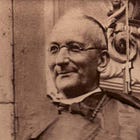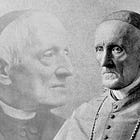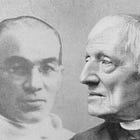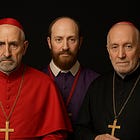Did four cardinals accuse Newman of heresy?
Is it true that so many eminent men accused and refuted Newman – and what would it mean, if this were so?
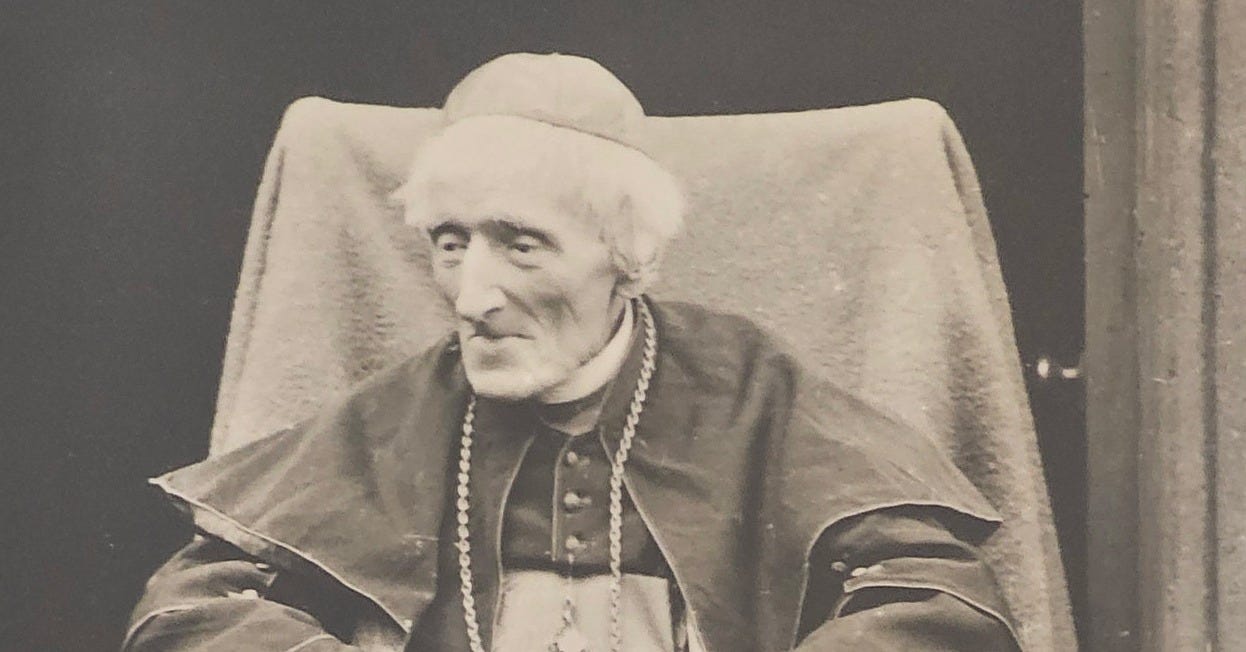
Is it true that so many eminent men accused and refuted Newman – and what would it mean, if this were so?
Introduction
A common charge against Newman is that four cardinals and a number of theologians accused him of heresy.
The four which are sometimes named in connection with this charge are Cardinals Lépicier, Manning, Franzelin and Billot.
While it is difficult to prove a universal negative, the usual sources cited do not show that these men accused Newman of heresy – as this rough memorandum will show.
What we do find are a delation by Bishop Brown (along with very different behaviour from him soon after), classroom and treatise-level clarifications by Franzelin and Lépicier, and shifting judgements over time.
Some of the topics are addressed directly in independent pieces; others may follow in due course.
Finally, we should also note that criticism from such men would not, by its mere existence, prove anything in particular. Even great men err; what would be important for such criticism – to the extent that it actually exists – is its content and whether it is just or not.
Cardinal Lépicier
Of the four cardinals named, Lépicier may be the most forceful in his engagement with Newman’s work. However, even he does not accuse Newman of heresy. As we have shown elsewhere, Lépicier praises Newman, seeks every opportunity to excuse him, and attacks the modernists who claim to derive their legitimacy from him.
Further, most of his criticisms are aimed at works written while Newman was an Anglican, which are obviously irrelevant when it comes to accusing him of heresy as a Catholic.
Cardinal Manning
There is an anecdote which holds that Manning accused Newman of “ten distinct heresies,” but we have demonstrated previously that this accusation rests on the authority of a Freemason who is far harsher about Manning’s character. We have also explained why such an anecdote is incompatible with other words spoken at the time – at least if Manning is to be taken as a man of integrity and a worthy judge of Newman’s alleged liberalism and heresy.
There is no doubt that Cardinal Manning had a difficult relationship with Newman for many years. However, if we are to avoid accusing Manning of open hypocrisy, it is necessary to conclude that his attitude softened over the years, such that he came to appreciate his fellow cardinal.
It is a fact that Manning praised Newman’s Letter to the Duke of Norfolk to the Roman authorities. He spoke very warmly of Newman in a eulogy when the latter died – which he was certainly not obliged to do. Even if he was compelled by circumstances to deliver a discourse, he could have been considerably more perfunctory than he was. As Don Félix Sardá y Salvany writes of those who “deliver funeral speeches in praise of notoriously liberal deceased persons”:
“It is well known that there are sins of which we are guilty, so to speak, not because we have actually and directly committed them, but because of mere complicity or collusion with their perpetrators. This complicity is of such a nature that it often equals in gravity the sinful action directly committed. Therefore, everything that moral theologians teach on this point of complicity can and should be applied to the sin of liberalism. Our aim here is simply to briefly outline the main ways in which this complicity with liberalism can be contracted today. […]
“10. It is complicity to celebrate civic or religious festivals for notoriously liberal or revolutionary acts; to voluntarily attend such festivals; to celebrate patriotic funerals that have more revolutionary significance than Christian suffrage; to deliver funeral speeches in praise of notoriously liberal deceased persons; to adorn their graves with wreaths and ribbons, etc. How many unwary people have faltered in their faith because of these causes!”1 (Emphasis added).
Those who wish to cite Manning as a witness against Newman as a “notoriously liberal person” are invited to explain how he avoids complicity with liberalism, which, as Don Sardá y Salvany explains, “is of such a nature that it often equals in gravity the sinful action directly committed.”
The certain words and actions of Manning must take precedence over rumours and spurious anecdotes. As such, anecdotes about Manning accusing Newman of heresy are without worth.
Cardinal Franzelin
Cardinal Franzelin is said to have “lectured against” Newman’s article Consulting the Faithful in Matters of Doctrine, following it being delated for heresy by Bishop Thomas Joseph Brown of Newport in 1859.
This is, then, the closest we come to the charge; however, it was a delation to Rome for a judgement, rather than a condemnation; and it was by Bishop Brown, rather than Cardinal Franzelin.
Although he was not contacted directly, men at Rome believed Newman to have ignored or refused to answer for the whole affair. In 1867, it emerged that this – rather than the article itself – was the chief cause of Newman having been “under a cloud” for the seven intervening years.
However, he did not ignore it at all. As soon as he heard of it, he had written to Cardinal Wiseman (who was in Rome at the time) asking for specifics – and declaring his submission to Rome’s decision in advance.
It is certain that both Manning and Mgr Talbot also so the letter.2 Wiseman appears to have passed this letter onto Propaganda, as its secretary sent him “a schedule of the statements in the Rambler article to which objection was taken.”3 A copy of the letter was later found in Wiseman’s belongings, and the schedule from Propaganda is in the Westminster Archdiocese Archive.
For whatever reason (perhaps Wiseman’s poor health), this list of charges was never forwarded to Newman, and Manning told him that the matter was settled. Around 1867, Manning was accused of having obscured the letter, which he strongly denied – and most critics believe him. However, Talbot also later admitted being against showing this letter to the Pope (and his advice was probably decisive). He appears to have become somewhat sheepish at his role in the whole affair when it came to light in 1867. It is a fact that both Manning and Talbot allowed Newman to be considered suspect at Rome for years his failure to reply.4
This is because the matter was not considered settled at Rome. When this became clear in 1867, Newman sent a copy of the letter to Rome; it was made known to Cardinal Barnabò and Pope Pius IX, and Newman’s good name was restored.
Completely reassured, all the Roman authorities desired was for Newman to put an explanation of the disputed passages into writing when the opportunity arose, with the assurance that whatever he wrote would be considered satisfactory. Newman took this opportunity in the publication of the fifth edition of Arians of the Fourth Century in 1871.
Before all this, it is true that Franzelin mentioned Newman in a lecture and denied what he understood to have been written in the Rambler article. The English Oratorians who uncovered the affair obtained a copy of Franzelin’s text, in order for Newman to answer it (which he did in 1871, as mentioned).
The text was later published as Thesis 12 in Franzelin’s De divine traditione (1871), after the controversy was resolved. While Franzelin does contradict the Rambler article directly in a single footnote, and some parts of the chapter appear to be engaging with the Rambler article, it is a stretch to call this a “lecturing against Newman” or even denouncing him in the classroom. In spite of the title of Thesis 12, the section dealt with a much broader range of topics, including the sort of assent which is owed to different types of truths, whether the magisterium could define truths that are only connected to the revealed deposit, and the nature of the minor censures.
In the small part of the chapter that dealt with the same topic as the Rambler article, Franzelin did not name Newman directly (referring instead to the article and the “anonymous author,” whom all knew to be Newman). At times, Franzelin seems to think that he is contradicting what Newman had written, even when making points that Newman was wrongly alleged to have denied (as demonstrated by the text itself, and in 1871).
Franzelin’s purpose in this text also seems to have been different from Newman’s. Franzelin was explaining the theological rationale behind historical facts which Newman himself affirmed (particularly, the dependence of the consensus fidelium on the ecclesia docens). While Newman’s account of the history of the Arian crisis might be disputed, he based it on respectable enough authorities (not least Baronius) and affirmed the relevant points of doctrine throughout. As such, it is unclear whether Franzelin was responding to the article or to isolated excerpts, and whether he had an integral translation of the text or not.
Finally, we should also note that Franzelin does not attach an accusation of heresy to his denial of Newman’s points: he simply states his denial, and explains the true doctrine (which, as stated, Newman did not in fact deny).
We note also that the orthodoxy of the article was affirmed at Rome even during the period of “the cloud” by Frs Valeriano Cardella SJ and Giovanni Perrone SJ – the former replying directly to Cardinal Franzelin,5 and the latter stating that he would had defended Newman with success in Rome.
In short, it seems an overstatement to describe Franzelin as accusing Newman of heresy.
Corollary: Bishop Thomas Joseph Brown of Newport
As a post-script to the case of Franzelin, we should note that Bishop Brown of Newport – the one who had delated the texts to Rome – evidently changed his perspective on Newman too.6
In 1867, when E.R. Martin revealed the existence of the “secret instruction” regarding Newman going to Oxford emerged, Brown “wrote to express his sympathy and support.”7 He wrote to Bishop Ullathorne in the same year, condemning the “violent part against poor Newman” on the universities question, assuring him that he would “reason with those who are violent and [show] them the evils likely to be caused by their opposition.”8 In addition to keeping Ullathrone informed of the movements of various parties in relation to this question, he promised to bring the question up with the Pope.
In April of the same year, he wrote again to Newman, calling him to “[seek] consolation in the recollection of how S. A. Liguori was misunderstood in the latter days of his life, and thereby perfected.”9 He also wrote to Ullathorne, assuring him that “there was no indisposition towards N. [Newman] manifested or even entertained” by the Roman Jesuits and the Civilta Cattolica.10
He had also written in approval of Newman’s Letter to Pusey (and adding his wish that Newman “could be induced to go on with the translation of Scripture”11 and The Dream of Gerontius.12
Brown had also repeatedly asked Newman to attend the Vatican Council as his theological adviser, and wrote in support at the time of the highly embarrassing leak of a letter to Bishop Ullathorne.13 He also suggested that if Newman’s views (“in which I fully occurred”) had been more represented at Vatican I, then various evils would have been avoided in the aftermath.14
On that note, when Gladstone’s Expostulation was published in 1874, Brown wrote to Newman and asked him “to become our David against the Goliath that threatens us all.”15 He wrote again praising him for so doing, in the Letter to the Duke of Norfolk.16
He also wrote kindly to him around the time of his elevation to the cardinalate:
“I hope the report is not true that you have absolutely refused the rank and title of Cardinal, of which no one known to me has been or is more deserving…
“If then your declining the Cardinalate be not final, allow me to implore you to intimate this to the Holy Father, or allow some one to do so. May I so inform him?”17
All in all, it is clear: Dr. Brown, the man who actually raised the question of heresy in relation to Newman, and who caused him the most harm with Rome, seems to have thoroughly regretted his actions and taken every opportunity to make amends for them afterwards.
Cardinal Billot
As stated, the fourth Cardinal is probably Cardinal Billot, and his work De Immutabilitate Traditionis contra Moderna Haeresim Evolutionismi has been cited as the source of of this criticism.
We have been unable to locate any direct engagement with Newman or his works in this book by Billot. We would be happy to examine any specific citations provided.
In the meantime, any covert engagement with Newman necessarily falls short of him being accused of several heresies by Billot.
Other theologians and writers
It is sometimes said that other theologians also accused in the same ways. The identity of these theologians, beyond the cardinals mentioned, is unclear – as are their objections.
Orestes Brownson is sometimes named in this regard. Brownson was an able polemicist and the author of some great works, although we have already explained why he is not a credible critic of Newman. Further, Brownson actually retracted his accusations, and admitted he had not even understood the question which Newman had sought to address.
One Professor Healy critiqued Newman’s article on the inspiration of Scripture, which was written prior to Leo XIII’s Providentissimus Deus. Newman responded to Healy, showing that his words did not diverge from the state of the question as it stood at the time18 – and, as the purpose of the article was to show what Catholics were obliged to believe, it appears that he stated the case correctly. It is unfair to judge Newman for taking a position on a question which was not, at that time, settled.
W.G. Ward was certainly opposed to some of Newman’s ideas, and may have raised the question of heresy. But Ward was notoriously free with this epithet. Further, he had been positive about works such as Letter to the Duke of Norfolk and Grammar of Assent.19 For these reasons, it does not seem just to point to Ward as evidence for the charge without mentioning these other details.
After Newman’s lifetime, Mgr Joseph Clifford Fenton critiqued him on the matter of papal infallibility. Even amidst this critique, however, Fenton states:
“The great English churchman made valuable additions to the Catholic literature on the history of dogma, on the spiritual life (particularly in the field of priestly perfection), and on the philosophy of education. His works on the genesis of faith and on the process of conversion to Catholic truth have placed the Church forever in his debt.
“The volumes which treat of these subjects, and which deal with the work of practical apologetic, represent the best and the characteristic thought of the most distinguished convert of the nineteenth century. They are far superior to his writings on the subject of papal infallibility.”20
We fully concede, as would no doubt would Newman himself, that “far more indiscriminate praise than really critical study has been given to his writings”21 – particularly amongst those who seek to marshal him in favour of their own ideas. We note that Fenton praises Benard’s positive A Preface to Newman’s Theology as a “critical and discriminating study.” We also agree with Fenton’s statement that “the traditional scientific exposition of papal infallibility” is “found at its best in works like Billot’s De Ecclesia,” rather than in polemical texts such as Newman’s Letter to the Duke of Norfolk.22 Nonetheless, despite frequently interpreting Newman’s words and actions in the worst possible light, Fenton still does not accuse him of heresy.
Fr Francisco Marín-Sola OP treated Newman in far more positive way, even while critiquing and correcting some of his ideas (particularly aspects of his terminology and methodology). While Marín-Sola was against “indifferently advising any Catholic young man” to read the Anglican-phase Essay on the Development of Christian Doctrine and certain other works, he still praised it warmly as a text which would help Protestants become Catholic. This is, in fact, the express reason for the work being published following Newman’s conversion, at the instigation and encouragement of ecclesiastical authority (particularly Cardinal Wiseman). Newman himself stated that he was prepared even to burn the work, if he was so instructed.23 It hardly seems just to critique Newman on the basis of this work.
We note, however, that Frs Perrone and Mazio (three Roman Jesuits) took a different position, and praised the work for its own merits. Contrary to the narrative of the Anglican minister Owen Chadwick in his sulfurously anti-Catholic work From Bossuet to Newman, Newman’s Essay was received well by Perrone and Mazio, cited at length by both, and influenced Perrone’s later work.24 Perrone also wrote a very supportive letter to Newman during the “flashpoint” of 1867, advising him that he had defended Newman in Rome when occasions arose. This letter was sent along with that of another Roman Jesuit, Fr Cardella, who had written with similar sentiments.
He was also later forcefully defended by Ferdinand Prat, in the face of Loisy’s claim to have been following Newman.25
Newman’s orthodoxy was also defended by his own ordinary Bishop Ullathorne. Bishop O’Dwyer of Limerick wrote an essay defending Newman from later charges of modernism – also rejected by Cardinal Lépicier. This essay earned a letter of approbation from Pope St Pius X. Fr Edmond D. Benard, a member of the faculty of Sacred Theology at the Catholic University of America, also wrote a work (mentioned by Fenton, above) explaining the nature and value of Newman’s writing for Catholics today.
Conclusion
In the face of these comments, it might be suggested that the number of concerns raised about Newman over the decades, and the number and weight of the names mentioned, should give us pause.
On the other hand, we could consider the words of Father Faber, in his Essay on Beatification and Canonization, who suggests that suffering at the hands of other good men is an “inseparable accident of sanctity.” He writes:
“But there is also another point which should not be forgotten , and which seems to render the isolation of the saintly character more complete and impressive . For if the differentia of the Saints is to be found in the combination of the marvellous and the eccentric, suffering, and of all sufferings especially the persecution and opposition of good men, seems to be an inseparable accident of sanctity, as soon as and insofar as it is heroic.
“It was necessary that Christ should suffer and so enter into His glory, is in its measure applicable to His saints. Hence an inquiry into this very thing forms part of the work of the Congregation of Rites. Not only are the sicknesses of the servant of God and the ordinary afflictions of his life inquired into, and the manner in which he bore them, but the falling away of his friends, the ridicule of the world, and the opposition of even good men, are investigated with special care, and that too while the dubium about his virtues is under consideration, as though these afflictions and thwartings were, so to speak, authentications which Providence is sure to give to heroic virtue, and of even a more convincing nature than miracles, seeing that the investigation of these cannot be entered upon until the dubium on the virtues has been solved and set at rest.
“Yet it is plain that these things add greatly to the likelihood of the Saint’s character being misunderstood, or giving offence at first sight; they impart a look of strangeness to his life; they naturally make us suspect singularity, or self-will , or at least a want of discretion in not keeping in favour with virtuous persons and authorities.”26
HELP KEEP THE WM REVIEW ONLINE WITH WM+!
As we expand The WM Review we would like to keep providing free articles for everyone.
Our work takes a lot of time and effort to produce. If you have benefitted from it please do consider supporting us financially.
A subscription gets you access to our exclusive WM+ material, and helps ensure that we can keep writing and sharing free material for all.
You can see what readers are saying over at our Testimonials page.
And you can visit The WM Review Shop for our ‘Lovely Mugs’ and more.
(We make our WM+ material freely available to clergy, priests and seminarians upon request. Please subscribe and reply to the email if this applies to you.)
Subscribe to WM+ now to make sure you always receive our material. Thank you!
Read Next:
Plus, some highlights:
Books
Bishop E.T. O’Dwyer – Cardinal Newman and the Encyclical Pascendi Dominici Gregis
Fr E.D. Benard – A Preface to Newman’s Theology
C. Michael Shea – Newman’s Early Roman Catholic Legacy, 1845-1854
Follow on Twitter, YouTube and Telegram:
Twitter (The WM Review)
Don Félix Sardá y Salvany, El liberalismo es pecado (trans. The WM Review). Chapter XII, pp. 55, 58-9, Online version.
Butler, Life and Times of Ullathorne, Vol. I, p. 318
Butler, Life and Times of Ullathorne, Vol. I, p. 318
Butler, Life and Times of Ullathorne, Vol. I, p. 318
We note that in 1852, before the Rambler controversy, Brown contributed financial assistance to Newman in the Achili trial, and wrote a letter requesting others join him in this endeavour.
Ker, p. 608
Ibid.
The original is available at NINS. A censored version, which does not name Healy, is available at Newman Reader.
W.G. Ward’s son, Wilfrid Ward, recounts his father’s reaction:
“He spoke in the Dublin Review with great cordiality of Newman’s pamphlet, and expressly denied that its positions could be charged with the ‘minimising’ tendency he had denounced. This gave the note for others who belonged to his school of thought, and the pamphlet was welcomed almost without a dissentient voice.”
Wilfrid Ward, Life of Cardinal Newman, Vol. 2, p 406. Longmans, Green and Co., London, 1912. Available at Newmanreader.org
Ibid.
Ibid. p. 320.
In a letter to Ullathorne in 1862, Newman wrote:
“When I became a Catholic, I sent a message to Dr Baggs [11 October 1845], that, at the word of the Bishops, I would put into the fire my then out-coming work on Development of Doctrine; and now, had I been writing on those subjects which most deeply inerest and distress me at this time, I trust I should have been equally ready to suppress my own convictions at the bidding of the Church.”
LD XX, p 379.
Cf. C. Michael Shea throughout. For the works that cite Newman, see:
Giacomo Mazio, “Liturgia Anglicana,” Annali delle Scienze Religiose, 2.5.13 (July–August 1847): 50–160; 2.5.14 (September–October 1847): 181–292.
Giovanni Perrone, “Della denominazione che la Chiesa Cattolica dà alle comunioni da lei divise di eretiche e di scismatiche,” Annali delle Scienze Religiose, 2.6.17 (March–April 1848): 215–21.
“In treating of the evolution of dogmas M. Loisy falls back on Newman, whom he fancies he religiously follows. But he has nothing in common with the great English apologist except the mere name of doctrinal development.
“Newman’s development is organic. He safeguards the identity of the object which is evolved. It is the regular growth of the man who without ceasing to be himself goes from childhood to youth, from youth to old age. The development of M. Loisy is a transformation. It is the mysterious unfolding of a germ into a living being. The germ is the Gospel; the living being is the Church. In fact he takes Harnack to task for not conceiving Christi anity as ‘a seed that has grown; a possible plant at first; a real one afterwards, identical with itself from the beginning of its evolution to its actual term, from its root to the tip of its stalk.’
“The difference at first sight is slight; but on reflection it will be seen that the identity of the germ and the living thing is not so certain, or that one will be the other; and whether it is or not M. Loisy puts it beyond the possibility of historical investigation. For there was never a microscope that in the germ revealed life or the specific character of its being. That differentiation comes only at a later stage. Thus the Gospel may indeed contain the Church in posse, but it is only after a long period of incubation that this relation reveals itself.
“Moreover Newman’s development is based on authority and legitimized by the infallible magisterium of the Church. Hence it leads spontaneously to Catholicism; and the solitary of Littlemore, who finished his work as a Protestant, signed it as a Catholic. But on the contrary the development of M. Loisy, which justifies itself by the need of living and operates by religious experience and Christian consciousness—whatever those terms may mean—makes straight for rationalistic Protestantism. If it does not reach it, it is by a lucky illogism.
“M. Loisy cannot therefore claim Newman as his model and guide.”
Ferdinand Prat, “M. Loisy’s Manifesto”, Études, November 5, 1903. Taken from D. Jackson’s On the Credibility of Certain Theologians.
Fr Frederick Faber, An essay on beatification, canonization, and the processes of the congregation of rites, pp. 37-8. Richardson and Son, London, 1848. Available at Hathi Trust.
Faber continues in the same section:
“We read in the Lives of the Saints of plans and actions which offend many even pious readers; they disapprove of them in themselves, they disapprove still more of their being held up either to the admiration or imitation of the faithful.
“Now if when the Saints themselves were alive, redolent with the odour of their sanctity , the vividness of their bright example and the solemn authentication of their frequent miracles fresh upon them and around them – if at at that time there was almost a general disapprobation of their plans and modes of action, as in the case of St. Alphonso Liguori, when he founded his Congregation, if, as again St. Alphonso was, they were left persisting in a kind of proud-looking isolation, if even popes and bishops were against them , and they gave way only to the pressure of actual command, if the pious were scandalized, and the holy Inquisition interfered , if calumny seemed for the while truth, and truth hypocrisy, if these wonderful men also went so far as to consider this opposition and offence the best proof they could have that their work was the Will of God, as St. Philip Neri and our good bishop Challoner are said often to have refused to join in a work because it was not opposed by good kind of men, if all this took place where they were personally concerned, must not something of the same sort be always expected towards their Lives, especially if those Lives be faithful and minute?
“And will not this easily account for the diversity of opinion and the somewhat offended temper of objection which Saints’ Lives have generally elicited? What the unkindly world, and the remaining worldliness in the ordinary faithful, found so uncongenial in the living Saints, will still be uncongenial in their Lives; although of course, in the case of Catholics, the intervention of the Church and the honours she has decreed to the Saint, will soften and diminish this, and will naturally make criticism less positive and more modest.
“Yet after all the fact remains: these are just the cases in which there has been this intervention of the Church; it is exactly these men and men like them whom the Church has singled out with her unerring instinct for canonization; men who have had to confront this opposition, jealousy, thwarting, and suspicion of the good, and who have passed through the terrific ordeal of this heart-breaking persecution; and this fact, without pushing it even as far as we might, will be found most difficult of explanation on any hypothesis of adversaries , and yet most imperiously requires one at their hands.” (pp. 39-40)
In reading Faber’s mention of St Alphonsus, we cannot help but recall Bishop Brown’s already-mentioned comparison of Newman with the saint, as Newman struggled under the cloud which Brown himself had created by his delation of the Rambler article.



